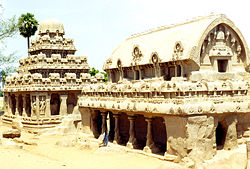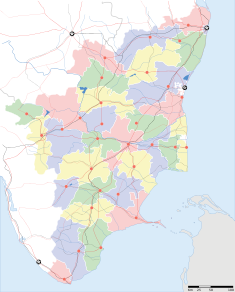Mahabalipuram
| Mahabalipuram Tamil Nadu • India | |
| Coordinates: | |
| Time zone | IST (UTC+5:30) |
| Area • Elevation |
• 12 m (39 ft) |
| District(s) | Kancheepuram |
| Population | 12,049 (2001) |
| Codes • Pincode • Telephone • Vehicle |
• 603104 • +91-44 • TN-21 |
Coordinates: Mahabalipuram (Tamil:மகாபலிபுரம்) (also known as Mamallapuram) is a town in Kancheepuram district in the Indian state of Tamil Nadu. It has an average elevation of 12 metres (39 feet).
Mahabalipuram was a 7th century port city of the South Indian dynasty of the Pallavas around 60 km south from the city of Chennai in Tamil Nadu. It is believed to have been named after the Pallava king Mamalla. It has various historic monuments built largely between the 7th and the 9th century, and has been classified as a UNESCO World Heritage Site.
Landmarks
The monuments are mostly rock-cut and monolithic, and constitute the early stages of Dravidian architecture wherein Buddhist elements of design are prominently visible. They are constituted by cave temples, monolithic rathas (chariots), sculpted reliefs and structural temples. The pillars are of the Dravidian order. The sculptures are excellent examples of Pallava art.
It is believed by some that this area served as a school for young sculptors. The different sculptures, some half finished, may have been examples of different styles of architecture, probably demonstrated by instructors and practiced on by young students. This can be seen in the Pancha Rathas where each Ratha is sculpted in a different style.
Some important structures include:
Thirukadalmallai
- Thirukadalmallai, the temple dedicated to Lord Vishnu. It was also built by Pallava King in order to safeguard the sculptures from the ocean. It is told that after building this temple, the remaining architecture was preserved and was not corroded by sea.
| Sri Sthalasayana Perumal | |
| [[Image:|200px| ]] Sthalasayana Perumal | |
| Temple Name: | ThiruKadalMallai |
|---|---|
| Alias Name: | Sthalasayana Perumal Kovil |
| God Name: | Sri Sthalasayana Perumal |
| Goddess Name: | Nilamangai Thayaar |
| Pushkarni: | Pundarika Pushkarni |
| Vimanam: | GaganaKriti Vimanam |
| Location: | Mahabalipuram |
| State and Country: | TamilNadu, India |
The Sthalasayana Perumal Temple is at Mahabalipuram. The Temple resides as the first and foremost of Mahabalipuram sculputres. It is one of the 108 Divya desam.
The temple
The temple stands on the shore and it was built along with the other sculptures. It is a small temple with two major Shrines for Lord Sthalasayana Perumal and Nilamangai Thayaar. This is the avatrasthalam(Birthplace) of Bhoothathazhwar, the 2nd Azhwar. There is also a separate shrine for Lord Narasimha. The architecture depicts the pallava style. This shrine was built by Pallava kings. Bhoothathazhwar was found in a tank that is opposite to the temple.
Legend
Sage Pundareeka was worshipping Lord Vishnu with Lotus flowers. Once the Sage Pundareeka started piling water from the ocean in order to get the divine vision of Lord Vishnu. Seeing his devotion, Lord Vishnu came in guise as an old man and asked for food. The Sage went to get food for the old man. When he returned he found Lord Vishnu in a Ananthasayana posture and wearing the lotus flowers which was offered by the sage. He then realised that it is Lord himself had come in disguise to bless the devotee.
Sri Sthalasayana Perumal Mahatyam
Lord Sthalasayana Perumal had come personally to fulfill his devotees wishes.
Prasadam
Puliyodharai (Tamarind Rice), Dhadhyonam (Curd Rice), Pongal, Chakkarai Pongal, Vada, Adhirasam, Murukku are offered to Lord as Prasadam.
Darshan, Sevas and Festivals Maasi Makham is an important festival.
Composers
Thirumangai Alvar, Bhoothathalvar have composed beautiful Paasurams on Lord Sthalasayana Perumal and his consort Nilamangai Thayaar. It is one of the compositions in Naalayira Divya Prabandha.
Travel and Stay
There are many lodges at Mahabalipuram and Chennai. Lot of bus facility available from Chennai. It is considered to be a great tourist destination from all over the world.
References
External links
Descent of the Ganges
- Descent of the Ganges - a giant open-air bas relief
Descent of the Ganges at Mahabalipuram, in the Tamil Nadu state India, is one of a group of monuments that were designated as a World Heritage Site since 1984.[1] It is a giant open-air relief carved of the a monolithic rock. The monuments and sanctuaries were built by the Pallava kings in the 7th and 8th centuries. The legend depicted in the relief is the story of the descent of the sacred river Ganga to earth from the heavens led by Bhagirata. The waters of Ganges are believed to possess supernatural powers.The descent of the Ganges and Arjuna's Penance are portrayed in stone at the Pallava heritage site[2]
See also
- Arjuna's Penance
- Varaha Cave Temple
- Shore Temple
- Pancha Rathas
Notes
- ↑ Group of Monuments at Mahabalipuram. Retrieved 2007-03-03.
- ↑ The Descent of the Ganges - Story of Bhagirata. Retrieved 2007-03-03.
External links
Arjuna's Penance
- Arjuna's Penance - relief sculpture on a massive scale extolling an episode from the Hindu epic, The Mahabharata.
Arjuna's Penance is the name of a massive open air bas-relief monolith dating from the 7th century CE located in the town of Mahabalipuram in Southern India. Measuring 96 feet long by 43 feet high, the bas-relief is also known as The Descent of Ganga. The bas-relief has two names, because there is not full agreement regarding which stories the mural depicts.
Two Interpretations
In one interpretation, a figure in the bas-relief who is standing on one leg is said to be Arjuna performing an austerity Tapas to receive a boon from Shiva as an aid in fighting the Mahabharata war. (The boon which Arjuna is said to have received was called Pasupata, Shiva's most powerful weapon).
The bas relief is situated on a rock with a cleft. Above the cleft was a collecting pool, and at one time, water may have flowed along the cleft. Figures within the cleft are said to represent Ganga or the River Ganges and Shiva. This provides the basis for an alternative interpretation of the mural. Rather than Arjuna, the figure performing austerities is said to be Bhagiratha. Bhagiratha is said to have performed austerities so that Ganga might descend to earth and wash over the ashes of his relatives, releasing them from their sins. To break Ganga's fall from heaven to earth, she falls onto Shiva's hair, and is divided into many streams by his tresses.
Figures
One of the notable, and perhaps ironic figures in the bas-relief is the figure of a cat standing on one leg (apparently as an austerity). This may be related to the Panchatantra story of the cat who poses as an ascetic in order to lure a hare and a bird to come near. (When near, he devours them.)
External links
Varaha Cave Temple
- Varaha Cave Temple - a small rock-cut temple dating back to the 7th century.
Shore Temple
- The Shore Temple - a structural temple along the Bay of Bengal with the entrance from the western side away from the sea. Recent excavations have revealed new structures here. The temple was reconstructed stone by stone from the sea after being washed away in a cyclone.
Pancha Rathas
- Pancha Rathas (Five Chariots) - five monolithic pyramidal structures named after the Pandavas (Arjuna, Bhima, Yudhishtra, Nakula and Sahadeva) and Draupadi. An interesting aspect of the rathas is that, despite their sizes they are not assembled—each of these is carved from one single large piece of stone.
| Group of Monuments at Mahabalipuram* | |
|---|---|
| UNESCO World Heritage Site | |

| |
| Type | Cultural |
| Criteria | i, ii, iii, iv |
| Reference | 249 |
| Region** | Asia-Pacific |
| Inscription history | |
| Inscription | 1984 (8th Session) |
| * Name as inscribed on World Heritage List. ** Region as classified by UNESCO. | |
Underwater city
According to descriptions by early travel writers from Britain, the area near Mahabalipuram had seven pagodas by the sea. Accounts of Mahabalipuram were first written down by British traveller John Goldingham who was told of the "Seven Pagodas" when he visited in 1798.
An ancient port city and parts of a temple built in the 7th century may have been uncovered by the tsunami that resulted from the 2004 Indian Ocean earthquake. As the waves gradually receded, the force of the water removed sand deposits that had covered various rocky structures and revealed carvings of animals, which included an elaborately carved head of an elephant and a horse in flight. A small square-shaped niche with a carved statue of a deity could be seen above the head of the elephant. In another structure, there was a sculpture of a reclining lion. The use of these animal sculptures as decorations is consistent with other decorated walls and temples from the Pallava period in the 7th and 8th centuries.
The Archaeological Survey of India sent divers to begin underwater excavations of the area on February 17, 2005.
Seven Pagodas of Mahabalipuram
Demography
Gallery
ReferencesISBN links support NWE through referral fees
External links
- Mahabalipuram
- Travel guide to Mahabalipuram from Wikitravel
- Mahabalipuram in UNESCO List
- Arjuna's Penance
- `I show you Mahabalipuram'
- National Institute of Oceanography: Mahabalipuram and Poompuhar
- Archaeological Survey of India site on Mahabalipuram
- Sea level falls after tsunami
- The Shore Temple stands its ground T.S. Subramanian in The Hindu, 30 December 2004
- Newly-discovered Mahabalipuramtemple fascinates archaeologists T.S. Subramanian in The Hindu, 10 April 2005
- Mahabalipuram Temple Architecture
- Mahabalipuram Photos from india-picture.net
- The India Atlantis Expedition - March 2002
- Read Useful Details about Mahabalipuram Temple
- Tsunami's might opens way for science (The Globe and Mail; February 18, 2005)
- BBC News: India finds more 'tsunami gifts'
- Inscriptions of India—Complete listing of historical inscriptions from Indian temples and monuments
- Photographs of Mahabalipuram and other sites in Tamil Nadu
- A videograph of Mahabalipuram in HD
| |||||||
References
Credits
New World Encyclopedia writers and editors rewrote and completed the Wikipedia article in accordance with New World Encyclopedia standards. This article abides by terms of the Creative Commons CC-by-sa 3.0 License (CC-by-sa), which may be used and disseminated with proper attribution. Credit is due under the terms of this license that can reference both the New World Encyclopedia contributors and the selfless volunteer contributors of the Wikimedia Foundation. To cite this article click here for a list of acceptable citing formats.The history of earlier contributions by wikipedians is accessible to researchers here:
The history of this article since it was imported to New World Encyclopedia:
Note: Some restrictions may apply to use of individual images which are separately licensed.








